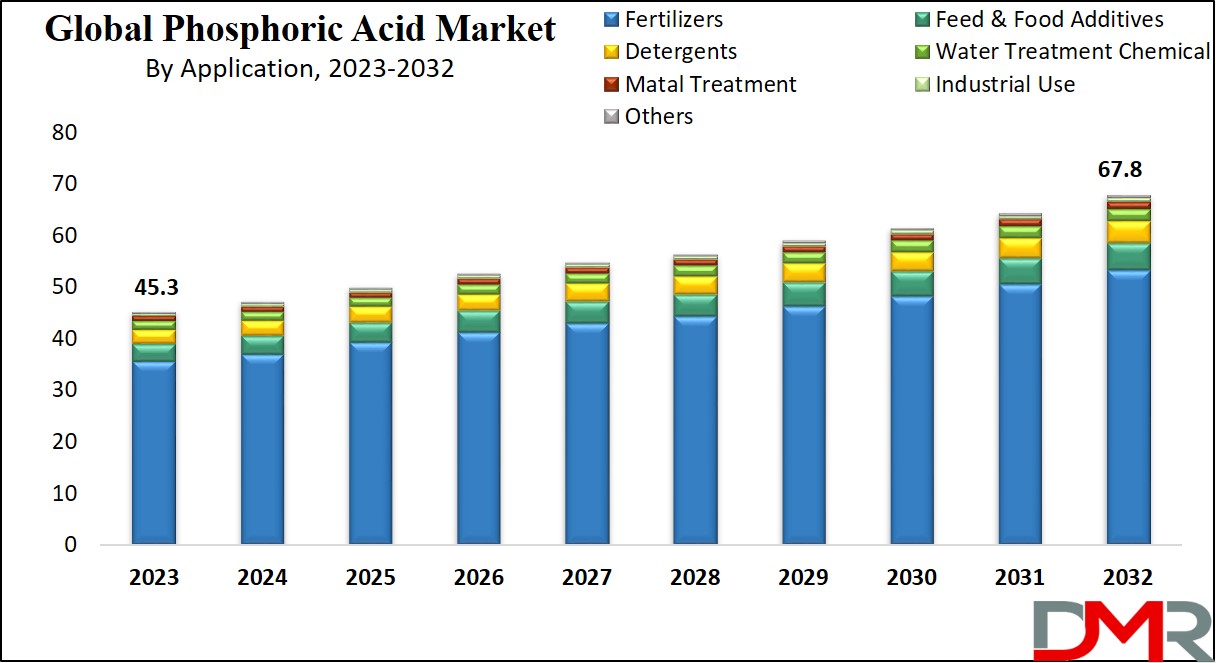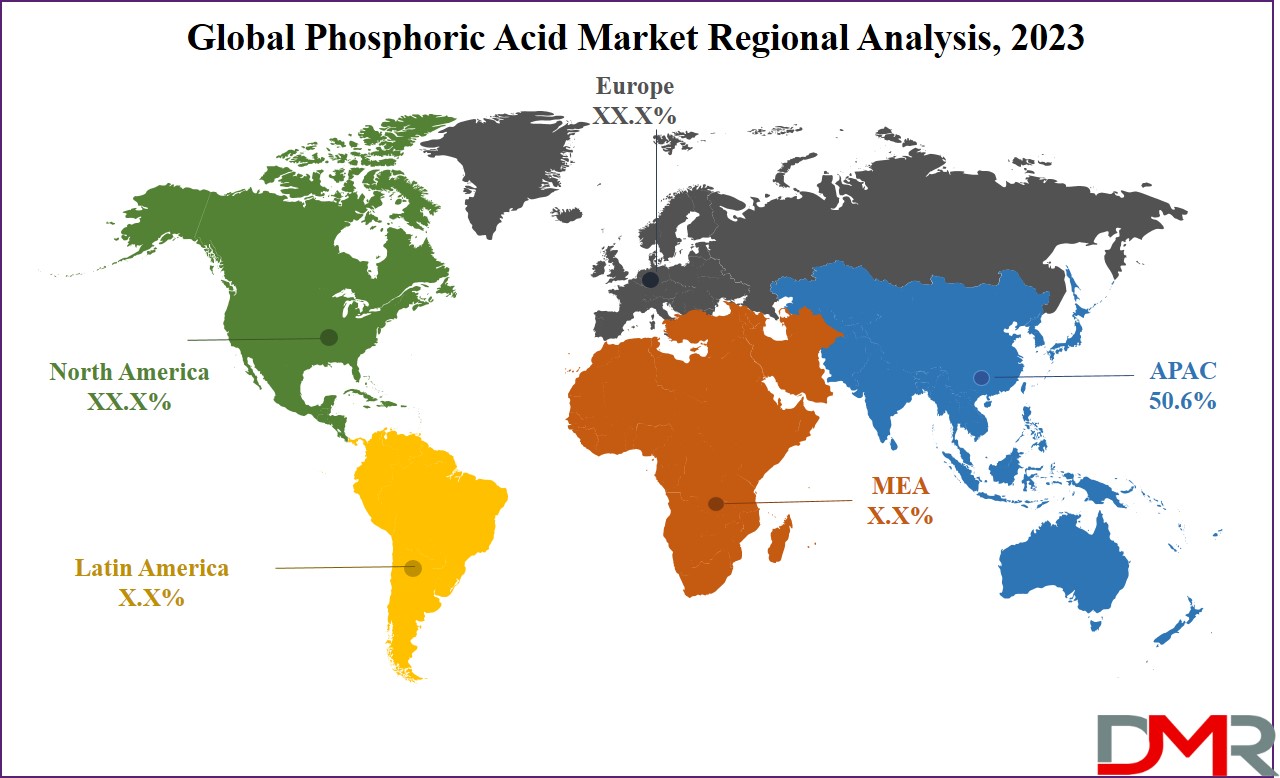Market Overview
The Global Phosphoric Acid Market is expected to hold a market
value of USD 45.3 billion by the end of 2023 and is further anticipated to reach a market value of
USD 67.8 billion by 2032 at a
CAGR of 4.6%.

The Global Phosphoric Market refers to the worldwide industry involved in the production, distribution & consumption of phosphoric acid, which is primarily used in the various industrial applications and production of fertilizers. This market plays a major role in a wide variety of sectors like
agriculture, food & beverage production, and
pharmaceutical industries. Phosphoric acid acts as a key element in the manufacturing process of fertilizers, impacting food production & agricultural productivity.
Market Dynamic
The Global Phosphoric Acid market is subjected to a complex market interplay that significantly affects the growth of this market. As phosphoric acid is a critical component in fertilizer production, this market is heavily influenced by agricultural demands, closely tied to factors such as population growth & shifts in food trends. This market is subjected to price fluctuations, influenced by factors like supply & demand, unstable raw material prices, and changes in regulating guidelines. For a long time, issues regarding phosphate rock mining & phosphoric acid production have been raised and actively discussed on how they are affecting the natural ecosystem and harming the environment. So, environmental regulations, trade policies, and manufacturing quality standards can influence the Global phosphoric acid market.
Research Scope and Analysis
By Source
Based on the source the Global Phosphoric Market is segmented into wet process & thermal process. In this segment wet process dominates the global market and is expected to hold a market share of 67.1% by the end of 2023. The wet process in phosphoric acid production is a widely used method that involves the extraction of phosphate rocks and its purification. The wet process can utilize various types of rocks, making it a preferred choice of manufacturer. The wet process is popular among manufacturers due to its cost-effectiveness and efficiency.

Furthermore, the acid produced by this process is of relatively high quality, and suitable for a wide range of applications, from fertilizer production to food & beverage additives. Moreover, the wet process generates less hazardous emissions compared to other processes, as it aligns with most of the existing production guidelines. This makes it a preferred choice for companies seeking to reduce their carbon footprint.
By Application
Fertilizers constitute the largest and most dominant application segment in the Global Phosphoric acid market. They play a crucial role in enhancing agricultural productivity and are subdivided into trisodium phosphate, diammonium phosphate, and monoammonium phosphate. The dominance of fertilizers can be attributed to the increasing demand for food. Phosphate-based fertilizers are popular and essential in meeting the demand by enhancing crop yield and ensuring optimal growth. These fertilizers are also popular for their balanced nutrient composition & easy application processes, making them indispensable in modern agriculture practices. Phosphoric acid-based fertilizers are highly versatile so they can be used in a wide range of crops and soil types making their contribution to the growth of this market vital.
These fertilizers are formulated to minimize the environmental impact, as they are equipped with controlled-release formulations designed to reduce nutrient runoff in soil and to preserve water quality. So, in other words, the dominance of fertilizers in this segment is rooted to its essential role in meeting global food demand, its versatility, environmental considerations & supportive government policies are contributing to the growth of this market.
The Global Phosphoric Acid Market Report is segmented on the basis of the following:
By Source
- Wet Process
- Thermal Process
By Application
- Fertilizers
- Diammonium Phosphate (DAP)
- Monoammonium Phosphate (MAP)
- Trisodium Phosphate (TSP)
- Feed & Food Additives
- Detergents
- Water Treatment chemical
- Metal Treatment
- Industrial Use
- Others
Regional Analysis
Aisa stands out as a significant player in the Global Phosphoric Acid Market as it holds the highest market share of 50.6% in 2023. The reason behind this region's dominant position is its growing agriculture sector. The agriculture sector of this region is driven by the rising population and increased food demand which positively impact the growth of the phosphoric acid market. These fertilizers are essential for improving crop yield, making Asia a key consumer of phosphoric acid. Another reason for this growth can be attributed to the manufacturing ecosystem of this region where countries like India, China & Vietnam are among the top producers of phosphoric acid in the world.

Additionally, major Asian countries are now focusing on sustainable agricultural practices & environment-friendly products. This shift towards eco-friendly, sustainable, and efficient fertilizers positively affects the demand for phosphoric acid and its derivatives.
By Region
North America
Europe
- Germany
- The U.K.
- France
- Italy
- Russia
- Spain
- Benelux
- Nordic
- Rest of Europe
Asia-Pacific
- China
- Japan
- South Korea
- India
- ANZ
- ASEAN
- Rest of Asia-Pacific
Latin America
- Brazil
- Mexico
- Argentina
- Colombia
- Rest of Latin America
Middle East & Africa
- Saudi Arabia
- UAE
- South Africa
- Israel
- Egypt
- Rest of MEA
Competitive Landscape
The competitive landscape of the Global Phosphoric Acid Market is marked by the dominance of established market leaders and emerging regional industries. OCP group, Mosaic Company, PhosAgro & Eurohem are among the industry giants that dominate the market. These companies have extensive consumer bases, diverse product catalogs, and extensive experience in phosphate-based product manufacturing.
The competitive landscape in the phosphoric acid market can change over time due to mergers, acquisitions, market expansion strategies, and emerging market trends. Additionally, environmental considerations & sustainability practices are rapidly becoming factors that shape the competitive landscape as well as consumer preference. The key players in the Global Phosphoric acid Market are The Mosaic Company, PJSC PhosAgro, Nutrien, IFFCO, EuroChem Group AG, Prayon Group, Israel Chemical Ltd., Yara International, OCP S.A., Aditya Birla Group, Arkema, Solvay S.A. and others.
Some of the prominent players in the Global Phosphoric Acid Market are:
- The Mosaic Company
- PJSC PhosAgro
- Nutrien
- IFFCO
- EuroChem Group AG
- Prayon Group
- Israel Chemical Ltd.
- Yara International
- OCP S.A.
- Aditya Birla Group
- Arkema
- Solvay S.A
- Other Key Players
COVID-19 Pandemic & Recession: Impact on the Global Phosphoric Acid Market:
The COVID-19 pandemic and the subsequent economic recession had significant effects on the global phosphoric acid market. The initial disruptions in the global supply chain and in production were caused by the lockdowns, and travel restrictions, that led to a temporary reduction in demand for phosphoric acid and phosphate-based products.
However, as the pandemic unfolded, the importance of food security became a serious issue as it led to a rapid growth in the demand for fertilizers and, consequently, phosphoric acid, as countries sought to maintain agricultural productivity. The shift towards sustainable and eco-friendly agricultural practices further influenced the market, with a growing focus on selective fertilizers. The pandemic also accelerated the adoption of digital technologies in agriculture, which positively influenced the use of the precise application of fertilizers and the demand for phosphoric acid-based products. Overall, the pandemic tested the resilience and adaptability of this market and also gave it new prospects to grow which will help this market grow further.
Report Details
| Report Characteristics |
| Market Size (2023) |
USD 45.3 Bn |
| Forecast Value (2032) |
USD 67.8 Bn |
| CAGR (2023-2032) |
4.6% |
| Historical Data |
2017 - 2022 |
| Forecast Data |
2023 - 2032 |
| Base Year |
2022 |
| Estimate Year |
2023 |
| Report Coverage |
Market Revenue Estimation, Market Dynamics, Competitive Landscape, Growth Factors and etc. |
| Segments Covered |
By Source (Wet Process and Thermal Process), By
Application (Fertilizers, Feed & Food Additives,
Detergents, Water Treatment chemical, Metal
Treatment, Industrial Use and Others) |
| Regional Coverage |
North America – The US and Canada; Europe – Germany, The UK, France, Russia, Spain, Italy, Benelux, Nordic, & Rest of Europe; Asia- Pacific– China, Japan, South Korea, India, ANZ, ASEAN, Rest of APAC; Latin America – Brazil, Mexico, Argentina, Colombia, Rest of Latin America; Middle East & Africa – Saudi Arabia, UAE, South Africa, Turkey, Egypt, Israel, & Rest of MEA
|
| Prominent Players |
Mosaic Company, PJSC PhosAgro, Nutrien, IFFCO,
EuroChem Group AG, Prayon Group, Israel Chemical
Ltd., Yara International, OCP S.A., Aditya Birla Group,
Arkema, Solvay S.A., and Other Key Players |
| Purchase Options |
We have three licenses to opt for: Single User License (Limited to 1 user), Multi-User License (Up to 5 Users), and Corporate Use License (Unlimited User) along with free report customization equivalent to 0 analyst working days, 3 analysts working days and 5 analysts working days respectively. |
Frequently Asked Questions
The Global Phosphoric Acid Market is expected to hold a market value of USD 45.3 billion by the end of
2023 and is further anticipated to reach a market value of USD 67.8 billion by 2032 at a CAGR of 4.6%.
Phosphoric acid is a mineral acid used in various industries like agriculture, pharmaceuticals, and
pharmaceuticals, primarily in the production of fertilizers, but also in food and beverages, detergents,
and industrial processes.
New trends that are emerging in the global phosphoric acid market are eco-friendly, sustainable, and
efficient products that affect the demand for phosphoric acid and its derivatives.
The key players in the Global Phosphoric acid Market are The Mosaic Company, PJSC PhosAgro, Nutrien,
IFFCO, EuroChem Group AG, Prayon Group, Israel Chemical Ltd., Yara International, OCP S.A., Aditya
Birla Group, Arkema, Solvay S.A. and others.